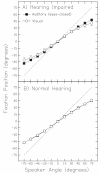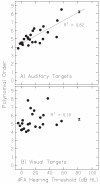Auditory and visual orienting responses in listeners with and without hearing-impairment
- PMID: 20550266
- PMCID: PMC4338612
- DOI: 10.1121/1.3409488
Auditory and visual orienting responses in listeners with and without hearing-impairment
Abstract
Head movements are intimately involved in sound localization and may provide information that could aid an impaired auditory system. Using an infrared camera system, head position and orientation was measured for 17 normal-hearing and 14 hearing-impaired listeners seated at the center of a ring of loudspeakers. Listeners were asked to orient their heads as quickly as was comfortable toward a sequence of visual targets, or were blindfolded and asked to orient toward a sequence of loudspeakers playing a short sentence. To attempt to elicit natural orienting responses, listeners were not asked to reorient their heads to the 0 degrees loudspeaker between trials. The results demonstrate that hearing-impairment is associated with several changes in orienting responses. Hearing-impaired listeners showed a larger difference in auditory versus visual fixation position and a substantial increase in initial and fixation latency for auditory targets. Peak velocity reached roughly 140 degrees/s in both groups, corresponding to a rate of change of approximately 1 micros of interaural time difference per millisecond of time. Most notably, hearing-impairment was associated with a large change in the complexity of the movement, changing from smooth sigmoidal trajectories to ones characterized by abruptly changing velocities, directional reversals, and frequent fixation angle corrections.
Figures









References
-
- Angell JR, Fite W. The Monaural Localization of Sounds. Psychol. Rev. 1901;8:225–246.
-
- Brimijoin WO, O’Neill WE. Measuring Inhibition and Facilitation in the Inferior Colliculus Using Vector-Based Analysis of Spectrotemporal Receptive Fields. Advances and Perspectives in Auditory Neurophysiology (abstracts) 2005;3
-
- Brungart DS, Durlach NI, Rabinowitz WM. Auditory localization of nearby sources. II. Localization of a broadband source. J. Acoust. Soc. Am. 1999;106:1956–1968. - PubMed
-
- de Bruijn NG. A Combinatorial Problem. Koninklijke Nederlandse Akademie v. Wetenschappen. 1946;49:758–764.
Publication types
MeSH terms
Grants and funding
LinkOut - more resources
Full Text Sources
Medical

